Assessing the Spatial Equity of Multi-Type Health Service Facilities: An Improved Method Integrating Scale Accessibility and Type Diversity
Abstract
:1. Introduction
2. Materials and Methods
2.1. Study Area
2.2. Data Source and Processing
- (1)
- Residential quarter
- (2)
- Population information
- (3)
- Pedestrian road network
- (4)
- Health service facilities
2.3. Methods
2.3.1. Assessing Comprehensive Accessibility Based on MT-G2SFCA
- Assessing facility scale accessibility for multi-type facilities
- 2.
- Assessing facility type diversity based on Shannon–Wiener index
- 3.
- Assessing comprehensive accessibility for multi-type facilities
2.3.2. Spatial Equality Evaluation Based on the Gini Coefficient and the Bivariate Local Moran’s I
2.3.3. Impact Factor Analysis Based on Geo-Detector
3. Results
3.1. The Spatial Differences in Accessibility between G2SFCA and MT-G2SFCA
3.2. The Spatial Equality of Comprehensive Accessibility Scores of HSFs
3.3. Impact Factor Exploration of the Comprehensive Accessibility of HSFs
4. Discussion
4.1. Neglecting the Service Benefits of Facility Type Diversity Leads to an Underestimation of the Comprehensive Accessibility
4.2. Ignoring the Heterogeneity of the Elderly Leads to an Overestimation of the Comprehensive Accessibility
4.3. PRD and Facility Point Density Are the Key Factors Affecting the Comprehensive Accessibility of HSFs
4.4. Policy and Planning Implications
- Refinement of planning standards tailored to different demographic groups.
- 2.
- Dynamic monitoring of the population situation.
- 3.
- Optimizing the urban slow-moving network.
- 4.
- Encouragement of mixed land use.
5. Conclusions
Author Contributions
Funding
Data Availability Statement
Acknowledgments
Conflicts of Interest
References
- Florian, L.; Peter, K.; Leila, H.; Fabian, S.; Heike, T. City living and urban upbringing affect neural social stress processing in humans. Nature 2011, 474, 498–501. [Google Scholar] [CrossRef] [PubMed]
- Richard, H. Urban health and well-being. Nature 2016, 531, S49. [Google Scholar] [CrossRef] [PubMed]
- Rydin, Y.; Bleahu, A.; Davies, M.; Dávila, J.D.; Friel, S. Shaping cities for health: Complexity and the planning of urban environments in the 21st century. Lancet 2012, 379, 2079–2108. [Google Scholar] [CrossRef] [PubMed]
- Yang, J.; Siri, G.J.; Remais, V.J.; Cheng, Q.; Zhang, H. The Tsinghua-Lancet Commission on Healthy Cities in China: Unlocking the power of cities for a healthy China. Lancet 2018, 391, 2140–2184. [Google Scholar] [CrossRef] [PubMed]
- Anu, R.; Armistead, G.R.; Patricia, J.C.; Karnamadakala, R.S.; Emani, K. Meta-principles for developing smart, sustainable, and healthy cities. Science 2016, 352, 940–943. [Google Scholar] [CrossRef] [PubMed]
- Grant, M. Integrating Health in Urban and Territorial Planning: A Sourcebook; UN-HABITAT and World Health Organization: Geneva, Switzerland, 2020. [Google Scholar]
- Wiktor, H.; Tomasz, S.; Wioletta, F.; Anna, S.; Sylwia, K. Assessment and planning of green spaces in urban parks: A review. Sustain. Cities Soc. 2023, 88, 104280. [Google Scholar] [CrossRef]
- Ejr, A.; Rmcbc, D.; Sbha, E.; Mb, A. Exposure to natural space, sense of community belonging, and adverse mental health outcomes across an urban region. Environ. Res. 2019, 171, 365–377. [Google Scholar] [CrossRef] [PubMed]
- Guida, C.; Carpentieri, G.; Masoumi, H. Measuring spatial accessibility to urban services for older adults: An application to healthcare facilities in Milan. Eur. Transp. Res. Rev. 2022, 14, 23. [Google Scholar] [CrossRef] [PubMed]
- Mahsa, B.; Reto, S.; Ulrike, W.H.; Felix, K.; Adrienne, G.R. Greater place attachment to urban parks enhances relaxation: Examining affective and cognitive responses of locals and bi-cultural migrants to virtual park visits. Landsc. Urban Plan. 2023, 232, 104650. [Google Scholar] [CrossRef]
- Sukanya, B.; Harini, N. Perceptions of park visitors on access to urban parks and benefits of green spaces. Urban For. Urban Green. 2021, 57, 126959. [Google Scholar] [CrossRef]
- Castells-Quintana, D.; Royuela, V. Are Increasing Urbanization and Inequalities Symptoms of Growth? Appl. Spat. Anal. Policy 2015, 8, 291–308. [Google Scholar] [CrossRef]
- Wan, J.; Zhao, Y.; Zhang, K.; Ma, C.; Sun, H.; Wang, Z. Healthy Community-Life Circle Planning Combining Objective Measurement and Subjective Evaluation: Theoretical and Empirical Research. Int. J. Environ. Res. Public Health 2022, 19, 5028. [Google Scholar] [CrossRef] [PubMed]
- Li, C.; Xia, W.; Chai, Y. Delineation of an Urban Community Life Circle Based on a Machine-Learning Estimation of Spatiotemporal Behavioral Demand. Chin. Geogr. Sci. 2021, 31, 27–40. [Google Scholar] [CrossRef]
- Liu, T.; Chai, Y. Daily life circle reconstruction: A scheme for sustainable development in urban China. Habitat Int. 2015, 50, 250–260. [Google Scholar] [CrossRef]
- Gan, X.Y.; Chen, J.B. Experience and Enlightenment of “Aging in Place” Service Facilities Planning in Italy: A Case Study of Milan. Urban Plan. Int. 2023, 38, 136–144. [Google Scholar]
- Wu, X.A.; Xu, L.Q.; Zhong, L. Key Indicators of 15-min Life Circle in the Standard for Urban Residential Area Planning and Design. Planners 2020, 36, 33–40. [Google Scholar]
- Wu, X.A.; Xu, L.Q. Research on the Form of Community Life Circle Planning: Discussion on the Scope of Age-Friendly Life Circle and Walking Friendly Life Circle. J. Hum. Settl. W. China 2021, 36, 74–82. [Google Scholar] [CrossRef]
- Louis, A.M.; Ulrike, J. Global interest in walking accessibility: A scoping review. Transplant. Rev. 2023, 43, 1021–1054. [Google Scholar] [CrossRef]
- Long, C.; Min, Y.; Jonas, D.V.; Frank, W. Examining geographical accessibility to multi-tier hospital care services for the elderly: A focus on spatial equity. J. Transp. Health 2020, 19, 100926. [Google Scholar] [CrossRef]
- Song, L.; Kong, X.S.; Cheng, P. Supply-demand matching assessment of the public service facilities in 15-minute community life circle based on residents’ behaviors. Cities 2024, 144, 104637. [Google Scholar] [CrossRef]
- Walter, G.H. How accessibility shapes land-use. J. Am. Inst. Plan. 1959, 25, 73–76. [Google Scholar] [CrossRef]
- Olle, J.; Henrikki, T.; Maria, S.; Rein, A. Dynamic cities: Location-based accessibility modelling as a function of time. Appl. Geogr. 2018, 95, 101–110. [Google Scholar] [CrossRef]
- Guo, S.H.; Song, C.; Pei, T. Accessibility to urban parks for elderly residents: Perspectives from mobile phone data. Landsc. Urban Plan. 2019, 191, 103642. [Google Scholar] [CrossRef]
- Wu, J.Y.; Chen, H.T.; Wang, H.Y. Will the opening community policy improve the equity of green accessibility and in what ways? Response based on a 2-step floating catchment area method and genetic algorithm. J. Clean. Prod. 2020, 263, 121454. [Google Scholar] [CrossRef]
- Xiao, Y.; Wang, D.; Fang, J. Exploring the disparities in park access through mobile phone data: Evidence from Shanghai, China. Landsc. Urban Plan. 2019, 181, 80–91. [Google Scholar] [CrossRef]
- Kesarovski, T.; Hernández-Palacio, F. Time, the other dimension of urban form: Measuring the relationship between urban density and accessibility to grocery shops in the 10-minute city. Environ. Plan. B Urban Anal. City Sci. 2022, 50, 44–59. [Google Scholar] [CrossRef]
- Weng, M.; Ding, N.; Li, J.; Jin, X.; Xiao, H.; He, Z. The 15-minute walkable neighborhoods: Measurement, social inequalities and implications for building healthy communities in urban China. J. Transp. Health 2019, 13, 259–273. [Google Scholar] [CrossRef]
- Alessia, C.; Richard, D.; Alex, N.; Alex, S. The 20-minute city: An equity analysis of Liverpool City Region. Transp. Res. Part D Transp. Environ. 2022, 102, 103111. [Google Scholar] [CrossRef]
- Liu, Z.B.; Zhang, C.; Dai, T.Q. Measuring Accessibility of Multi-Type Urban Public Service Facilities with Entropy in Beijing. Econ. Geogr. 2018, 38, 77–84. [Google Scholar] [CrossRef]
- Xia, N.; Cheng, L.; Chen, S.; Wei, X.; Zong, W.; Li, M. Accessibility based on Gravity-Radiation model and Google Maps API: A case study in Australia. J. Transp. Geogr. 2018, 72, 178–190. [Google Scholar] [CrossRef]
- Hu, L.; Zhao, C.; Wang, M.; Su, S.; Weng, M.; Wang, W. Dynamic healthy food accessibility in a rapidly urbanizing metropolitan area: Socioeconomic inequality and relative contribution of local factors. Cities 2020, 105, 102819. [Google Scholar] [CrossRef]
- Hu, S.; Song, W.; Li, C.; Lu, J. A multi-mode Gaussian-based two-step floating catchment area method for measuring accessibility of urban parks. Cities 2020, 105, 102815. [Google Scholar] [CrossRef]
- Zhai, S.Y.; He, X.X.; Kong, Y.F.; Luo, J.J.; Song, G.X. Measuring the spatial accessibility of public services by optimal supply-demand allocation. Acta Geogr. Sin. 2022, 77, 1028–1038. [Google Scholar]
- Chen, X. Enhancing the Two-Step Floating Catchment Area Model for Community Food Access Mapping: Case of the Supplemental Nutrition Assistance Program. Prof. Geogr. 2019, 71, 668–680. [Google Scholar] [CrossRef]
- Xia, Z.L.; Li, H.; Chen, Y.H.; Yu, W.H. Integrating Spatial and Non-Spatial Dimensions to Measure Urban Fire Service Access. ISPRS Int. J. Geo-Inf. 2019, 8, 138. [Google Scholar] [CrossRef]
- Dai, W.; Yuan, S.; Liu, Y.; Peng, D.; Niu, S. Measuring equality in access to urban parks: A big data analysis from Chengdu. Front. Public Health 2022, 10, 1022666. [Google Scholar] [CrossRef]
- Dai, D. Black residential segregation, disparities in spatial access to health care facilities, and late-stage breast cancer diagnosis in metropolitan Detroit. Health Place 2010, 16, 1038–1052. [Google Scholar] [CrossRef] [PubMed]
- Dai, D.J. Racial/ethnic and socioeconomic disparities in urban green space accessibility: Where to intervene? Landsc. Urban Plan. 2011, 102, 234–244. [Google Scholar] [CrossRef]
- Zhang, S.; Yu, P.; Chen, Y.; Jing, Y.; Zeng, F. Accessibility of Park Green Space in Wuhan, China: Implications for Spatial Equity in the Post-COVID-19. Era. Int. J. Environ. Res. Public Health 2022, 19, 5440. [Google Scholar] [CrossRef]
- Jamtsho, S.; Corner, R.; Dewan, A. Spatio-temporal analysis of spatial accessibility to primary health care in Bhutan. ISPRS Int. J. Geo. Inf. 2015, 4, 1584–1604. [Google Scholar] [CrossRef]
- Coline, C.D.; Eric, M.D.; Elizabeth, C.D. Re-conceptualizing accessibility to parks in multi-modal cities: A variable-width floating catchment area (VFCA) method. Landsc. Urban Plan. 2015, 143, 90–99. [Google Scholar] [CrossRef]
- Matthew, R.M.; John, S.H. Measuring spatial accessibility to primary health care services: Utilising dynamic catchment sizes. Appl. Geogr. 2014, 54, 182–188. [Google Scholar] [CrossRef]
- Mitchel, L.; Gary, H.; Richard, F. Multi-modal two-step floating catchment area analysis of primary health care accessibility. Health Place 2016, 38, 70–81. [Google Scholar] [CrossRef] [PubMed]
- Fransen, K.; Neutens, T.; Maeyer, P.D.; Deruyter, G. A commuter-based two-step floating catchment area method for measuring spatial accessibility of daycare centers. Health Place 2015, 32, 65–73. [Google Scholar] [CrossRef] [PubMed]
- Luo, J. Integrating the Huff Model and floating catchment area methods to analyze spatial access to healthcare services. Trans. GIS 2014, 18, 436–448. [Google Scholar] [CrossRef]
- Subal, J.; Paal, P.; Krisp, J.M. Quantifying spatial accessibility of general practitioners by applying a modified huff three-step floating catchment area (MH3SFCA) method. Int. J. Health Geogr. 2021, 20, 9. [Google Scholar] [CrossRef] [PubMed]
- Zhang, R.; Peng, S.; Sun, F.; Deng, L.; Che, Y. Assessing the social equity of urban parks: An improved index integrating multiple quality dimensions and service accessibility. Cities 2022, 129, 103839. [Google Scholar] [CrossRef]
- Elldér, E.; Haugen, K.; Vilhelmson, B. When local access matters: A detailed analysis of place, neighbourhood amenities and travel choice. Urban Stud. 2022, 59, 120–139. [Google Scholar] [CrossRef]
- Romain, G.; Zahra, K.; Vladimir, C.; Ulla, M.; Brian, D.; Georgia, D. Distinction, quantification and mapping of potential and realized supply-demand of flow-dependent ecosystem services. Sci. Total Environ. 2017, 593–594, 599–609. [Google Scholar] [CrossRef]
- Uta, S.; Sebastian, C.; Lukas, E.V.; Hieronymus, J.; Alice, L.; Thomas, M. Integrating supply, flow and demand to enhance the understanding of interactions among multiple ecosystem services. Sci. Total Environ. 2019, 651, 928–941. [Google Scholar] [CrossRef]
- Cai, W.B.; Jiang, W.; Du, H.Y.; Chen, R.S.; Cai, Y.L. Assessing Ecosystem Services Supply-Demand (Mis) Matches for Differential City Management in the Yangtze River Delta Urban Agglomeration. Int. J. Environ. Res. Public Health 2021, 18, 8130. [Google Scholar] [CrossRef] [PubMed]
- Khavarian-Garmsir, A.R.; Sharifi, A.; Sadeghi, A. The 15-minute city: Urban planning and design efforts toward creating sustainable neighborhoods. Cities 2023, 132, 104101. [Google Scholar] [CrossRef]
- Li, C.Y.; Wang, J.R. Using an age-grouped Gaussian-based two-step floating catchment area method (AG2SFCA) to measure walking accessibility to urban parks: With an explicit focus on elderly. J. Transp. Geogr. 2024, 114, 103772. [Google Scholar] [CrossRef]
- Whitehead, J.; Pearson, A.L.; Lawrenson, R.; Atatoa-Carr, P. How can the spatial equity of health services be defined and measured? A systematic review of spatial equity definitions and methods. J. Health Serv. Res. Policy 2019, 24, 270–278. [Google Scholar] [CrossRef]
- Ma, Y.L.; Xiong, H.; Jiang, X.B. Analysis of Influence of Pedestrian Character on Walking Behavior. Traffic Transp. 2009, 1, 98–101. [Google Scholar]
- Cai, T.P.; Shao, X.H.; Long, J.W. Meta-analysis of gait speed test in healthy elderly. J. Nanchang Univ. (Med. Sci.) 2020, 60, 44–52. [Google Scholar] [CrossRef]
- Zhang, F.; Li, D.Z.; Sherry, A.; Zhang, J.K. Assessing spatial disparities of accessibility to community-based service resources for Chinese older adults based on travel behavior: A city-wide study of Nanjing, China. Habitat Int. 2019, 88, 101984. [Google Scholar] [CrossRef]
- Willberg, E.; Fink, C.; Toivonen, T. The 15-minute city for all?—Measuring individual and temporal variations in walking accessibility. J. Transp. Geogr. 2023, 106, 103521. [Google Scholar] [CrossRef]
- Li, Y.; Ran, Q.C.; Yao, S.; Ding, L. Evaluation and Optimization of the Layout of Community Public Service Facilities for the Elderly: A Case Study of Hangzhou. Land 2023, 12, 629. [Google Scholar] [CrossRef]
- Li, M. The planning strategies of a 15-minute community life circle based on behaviors of residents. Urban Plan. Forum 2017, 1, 111–118. [Google Scholar] [CrossRef]
- Li, M.; Hu, G.Y.; Huang, J.Z. Research on the demand characteristics of community service facilities for the elderly in Shanghai: Based on the perspective of walking abilities difference. Shanghai Urban Plan. Rev. 2017, 1, 25–31. [Google Scholar]
- Wang, J.; Jiao, Y.; Ren, Y.P.; Xue, Y.; Ji, Y.P.; Xu, B.D. Comparative study on two computing methods for estimating Shannon-Wiener diversity index. J. Fish. China 2015, 39, 1257–1263. [Google Scholar]
- Chen, Y.L.; Yu, P.H.; Li, Z.G.; Wang, J.; Chen, Y.Y. Environmental Equity Measurement of Urban Green Space from the Perspective of SDG11: A Case Study of the Central Urban Area of Wuhan. Geogr. Geo-Inf. Sci. 2021, 37, 8189. [Google Scholar] [CrossRef]
- Lorenz, M. Methods of measuring the concentration of wealth. Am. Stat. Assoc. 1905, 9, 209–219. [Google Scholar] [CrossRef]
- Wang, J.F.; Xu, C.D. Geodetector: Principle and prospective. Acta Geogr. Sin. 2017, 72, 116–134. [Google Scholar]
- Wang, J.F.; Li, X.H.; Christakos, G.; Liao, Y.L.; Zhang, T.; Gu, X. Geographical detectors-based health risk assessment and its application in the neural tube defects study of the Heshun region, China. Int. J. Geogr. Inf. Sci. 2010, 24, 107–127. [Google Scholar] [CrossRef]
- Zhao, J.; Su, W.; Luo, J.C.; Zuo, J. Evaluation and Optimization of Walkability of Children’s School Travel Road for Accessibility and Safety Improvement. Int. J. Environ. Res. Public Health 2021, 19, 71. [Google Scholar] [CrossRef] [PubMed]
- Li, D.Y.; Zang, H.Y.; Yu, D.M.; He, Q.L.; Huang, X.R. Study on the Influence Mechanism and Space Distribution Characteristics of Rail Transit Station Area Accessibility Based on MGWR. Int. J. Environ. Res. Public Health 2023, 20, 1535. [Google Scholar] [CrossRef] [PubMed]
- Fang, B.; Shi, F. Research Progress and Prospects of Street Connectivity Measurements: A Study on How to Popularize Block System in China from the Prospective of Regulations. Urban Plan. Int. 2019, 34, 72–78. [Google Scholar] [CrossRef]
- Jiang, J.C.; Chen, J.P.; Yu, J. Research on Live Connectivity of Road Network. Geomat. Spat. Inf. Technol. 2010, 33, 81–83+86. [Google Scholar] [CrossRef]
- Khaled, A.; Asim, K.; Azhar, D.; Rahma, A. Revisiting transit-oriented development: Alleys as critical walking infrastructure. Transp. Policy 2021, 100, 187–202. [Google Scholar] [CrossRef]
- Shen, J.; Chun, T.; Niu, Q.; Wei, W.; Peng, Y. Evaluation and Difference Analysis of Built Environment Walking Demands in Urban Residential Areas: A Case Study of Five Types of Residential Areas in Wuhan. Planners 2020, 36, 38–44. [Google Scholar]
- Xing, L.J.; Chen, Q.; Liu, Y.L.; He, H.G. Evaluating the accessibility and equity of urban health resources based on multi-source big data in high-density city. Sustain. Cities Soc. 2024, 100, 105049. [Google Scholar] [CrossRef]
- Calimport, S.R.G.; Bentley, B.L.; Stewart, C.E.; Pawelec, G.; Scuteri, A.; Vinciguerra, M. To help aging populations, classify organismal senescence. Science 2019, 366, 576–578. [Google Scholar] [CrossRef] [PubMed]
- John, R.B.; Alana, O.; Islene, A.D.C.; Ritu, S.; Anne, M.P.; Jean-Pierre, M. The World report on ageing and health: A policy framework for healthy ageing. Lancet 2016, 387, 2145–2154. [Google Scholar] [CrossRef]
- Dixon, A. The United Nations Decade of Healthy Ageing requires concerted global action. Nat. Aging 2021, 1, 2. [Google Scholar] [CrossRef] [PubMed]
- Freedman, V.A.; Kasper, J.D. Cohort Profile: The National Health and Aging Trends Study (NHATS). Int. J. Epidemiol. 2019, 48, 1044–1045. [Google Scholar] [CrossRef]
- Aging in unity. Nat. Aging 2021, 1, 1. [CrossRef] [PubMed]
- Zhang, Y.; Wang, R.; WU, Y.; Chu, G.L.; Wu, X.M. The Influence of Built-Environment Factors on Connectivity of Road Networks in Residential Areas: A Study Based on 204 Samples in Nanjing, China. Buildings 2023, 13, 301. [Google Scholar] [CrossRef]
- Yin, H.Y.; Li, J.Y.; Shi, T.; Zhao, D.; Yang, J.H.; Li, J.X. Objective influencing factors of urban park accessibility. Chin. J. Appl. Ecol. 2016, 27, 3387–3393. [Google Scholar] [CrossRef]
- Xing, L.J.; Du, S.N.; Tong, Z.M.; Zhang, L. Spatial and temporal accessibility of urban green space and its influencing factors in Wuhan from the perspective of environmental justice. Acta Ecol. Sin. 2023, 43, 5370–5382. [Google Scholar] [CrossRef]
- Petter, N.; Arvid, S.; Fitwi, W.; Harpa, S. Residential location, commuting and non-work travel in two urban areas of different size and with different center structures. Prog. Plan. 2017, 128, 1–36. [Google Scholar] [CrossRef]
- Erik, E. What Kind of Compact Development Makes People Drive Less? The “Ds of the Built Environment” versus Neighborhood Amenities. J. Plan. Educ. Res. 2018, 40, 432–446. [Google Scholar] [CrossRef]
- Wang, D.; Brown, G.; Liu, Y. The physical and non-physical factors that influence perceived access to urban parks. Landsc. Urban Plan. 2015, 133, 53–66. [Google Scholar] [CrossRef]


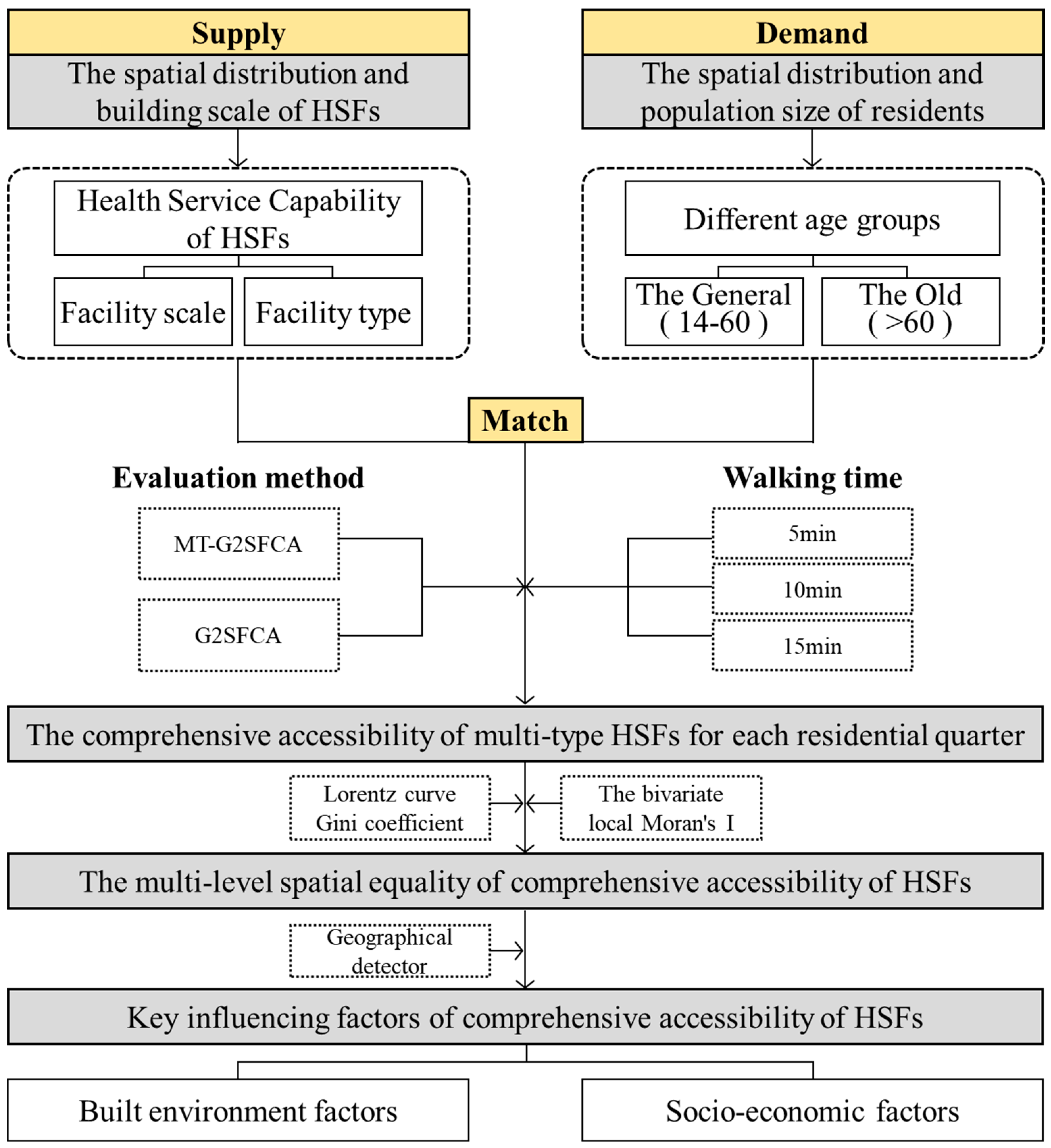
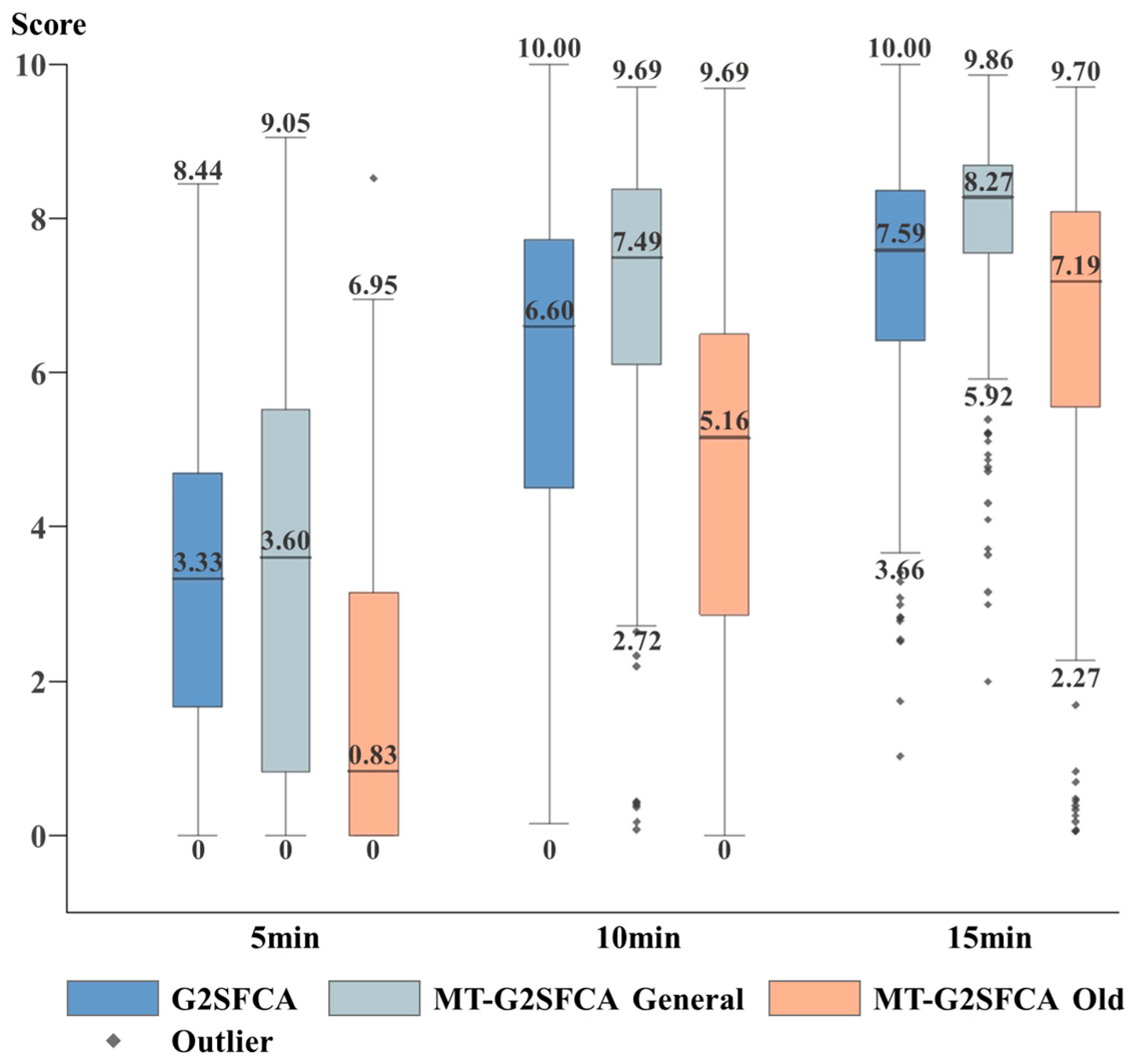
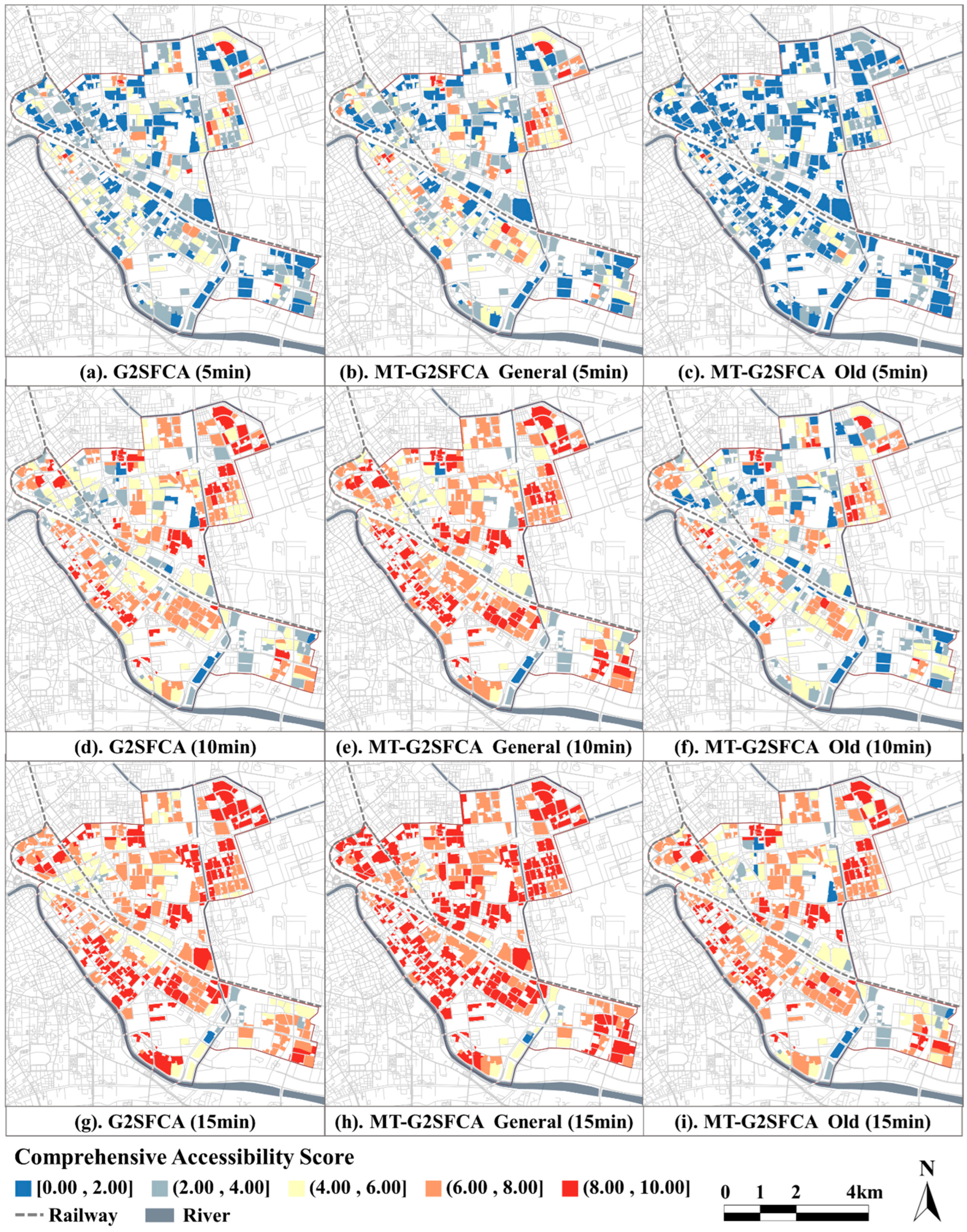
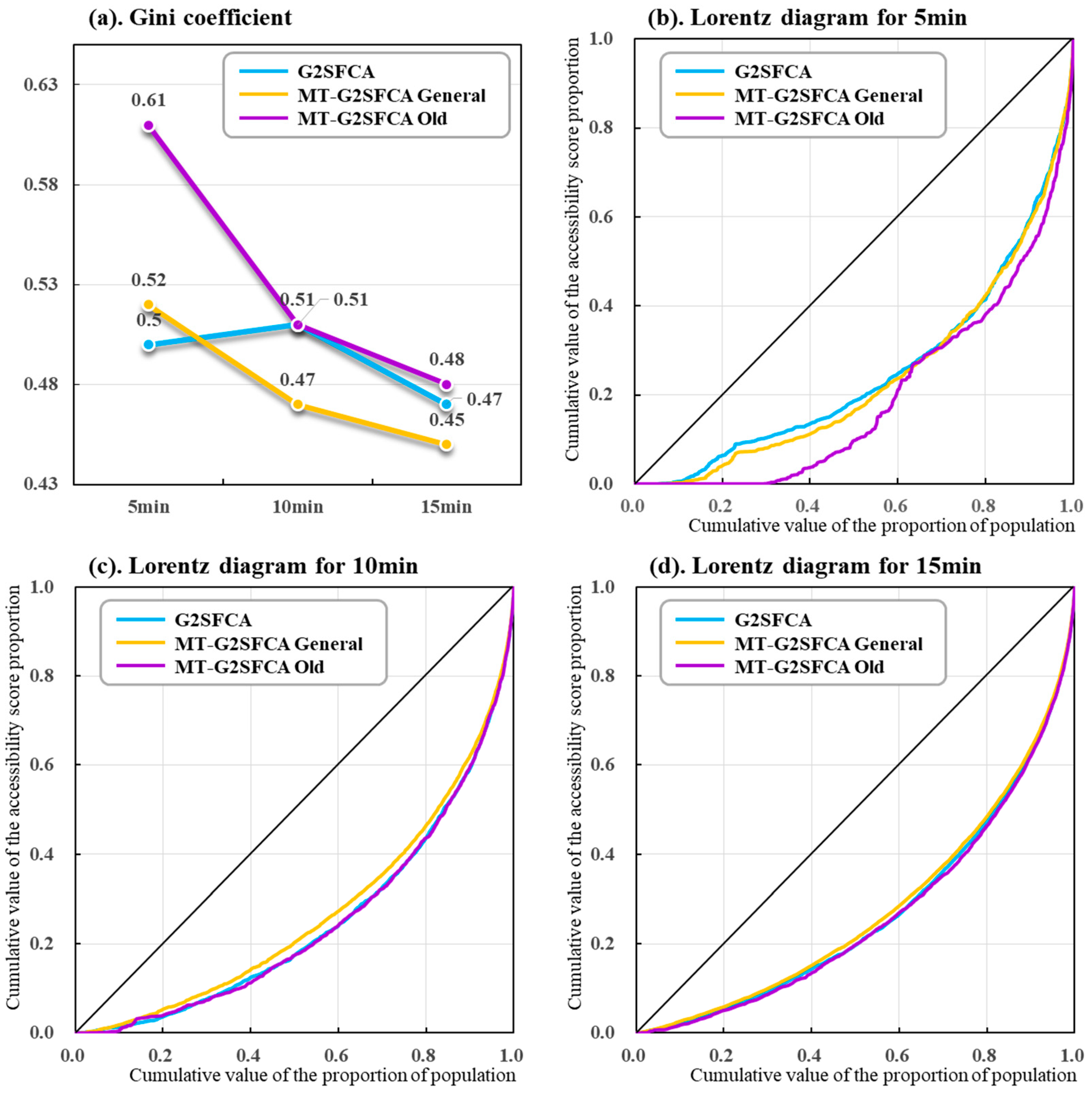
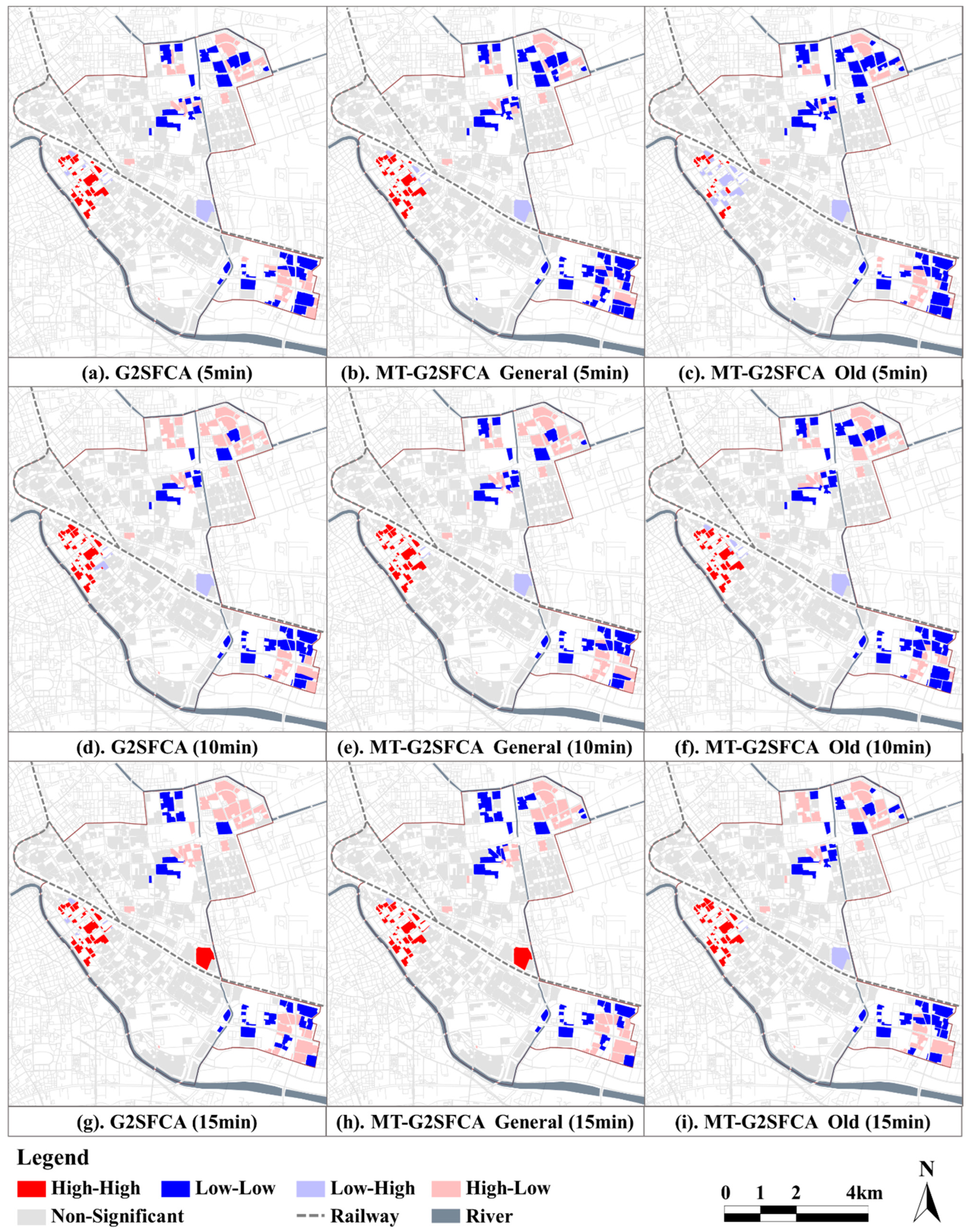



| Type | Number | Standard Value of Per Capita Index (per m2) |
|---|---|---|
| Outpatient department | i = 1 | 0.03 |
| Community hospital | i = 2 | 0.02 |
| Cultural activity center | i = 3 | 0.06 |
| Community service center | i = 4 | 0.014 |
| Vegetable market | i = 5 | 0.05 |
| City Park | i = 6 | 4.5 |
| Dimension | Variables | Calculation Formula | Quantitative Interpretation |
|---|---|---|---|
| Built environment factor | Pedestrian road density [69,70,73] | X = Li/Si | Li is the sum of pedestrian road lengths within the unit. Si is the total scale of the unit. Ei is the amount of sections of the pedestrian network in the unit. Wi is the amount of nodes in the pedestrian network within the unit. Sk is the actual walking scale of the residential quarter. Sr is the standard circular scale of radius do. Pk is the amount of population in the residential quarter. Pi is the sum of population in the unit. Fi is the amount of HSFs in the unit. Dk is the per capita scale of facilities available for residential quarters. Pn is the housing price of the residential quarter within the unit. n is the amount of residential quarters in the unit. |
| Connectivity of pedestrian network [68,71] | X = 2Ei/Wi | ||
| Node density [70,73] | X = Wi/Si | ||
| PRD (Pedestrian Route Directness) [70,72,73] | X = ∑(Pk × Sk/Sr)/Pi | ||
| Socio-economic factor | Population density [69] | X = Pi/Si | |
| Facility point density [69] | X = Fi/100Si | ||
| Per capita facility scale [73] | X = ∑(Dk × Pk)/Pi | ||
| Average housing price [69] | X = ∑Pn/n |
| Abbreviation | Explanation | Abbreviation | Explanation |
|---|---|---|---|
| HSF | Health service facility | MT-G2SFCA | Multi-type Gaussian-based two-step floating catchment area method |
| HSFs | Health service facilities | G2SFCA | Gaussian-based two-step floating catchment area method |
| PRD | Pedestrian Route Directness | HH | High accessibility–High population density |
| POI | Point of Interest | HL | Low accessibility–High population density |
| API | Application Programming Interface | LH | High accessibility–Low population density |
| WHO | World Health Organization | LL | Low accessibility–Low population density |
Disclaimer/Publisher’s Note: The statements, opinions and data contained in all publications are solely those of the individual author(s) and contributor(s) and not of MDPI and/or the editor(s). MDPI and/or the editor(s) disclaim responsibility for any injury to people or property resulting from any ideas, methods, instructions or products referred to in the content. |
© 2024 by the authors. Licensee MDPI, Basel, Switzerland. This article is an open access article distributed under the terms and conditions of the Creative Commons Attribution (CC BY) license (https://creativecommons.org/licenses/by/4.0/).
Share and Cite
Zeng, Y.; Zuo, J.; Li, C.; Luo, J. Assessing the Spatial Equity of Multi-Type Health Service Facilities: An Improved Method Integrating Scale Accessibility and Type Diversity. Land 2024, 13, 795. https://doi.org/10.3390/land13060795
Zeng Y, Zuo J, Li C, Luo J. Assessing the Spatial Equity of Multi-Type Health Service Facilities: An Improved Method Integrating Scale Accessibility and Type Diversity. Land. 2024; 13(6):795. https://doi.org/10.3390/land13060795
Chicago/Turabian StyleZeng, Yun, Jin Zuo, Chen Li, and Jiancheng Luo. 2024. "Assessing the Spatial Equity of Multi-Type Health Service Facilities: An Improved Method Integrating Scale Accessibility and Type Diversity" Land 13, no. 6: 795. https://doi.org/10.3390/land13060795






